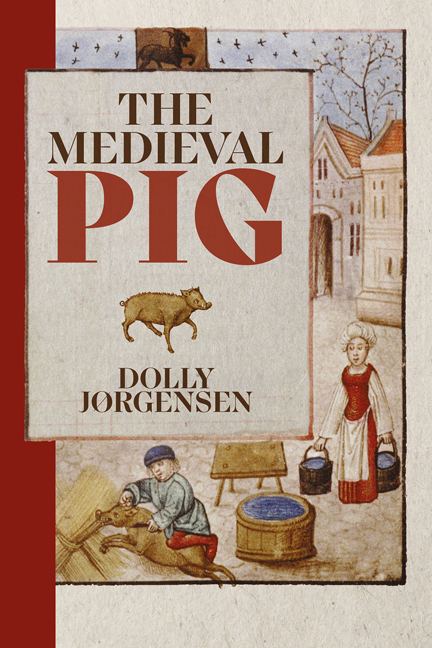3 - In the City
Published online by Cambridge University Press: 11 May 2024
Summary
The large, br istly pig leads the way on the street. The swineherd follows behind, holding on tight to a rope tied around the animal's back leg. He uses his stick to guide the pig, possibly striking it on the rump if it stops in an unwanted spot. They are probably on their way either to the city's market or the slaughterhouse. The artist drew this pig and his keeper in a manuscript in fourteenth-century France to depict snapshots of urban life, and naturally animals such as pigs were part of the scene (Figure 10). Pigs were as integrated into the cityscape as they were into the countryside of medieval Europe.
Pigs would have been brought on the hoof into cities and towns to be sold at markets. Manors around large urban centres such as Paris or London could be guaranteed to have outlets for selling excess swine. A study of manors in the London area around 1300 showed that over half of them sold pigs. Some of these estates made a significant income from selling pigs to urban markets. The mean sale price of non-breeding meat pigs was twice that of an adult sheep and two and a half times that for a beef calf. Pigs could be big business as marketed commodities.
Yet pigs were not just rural residents itinerantly in the city – they lived there all the time and many townspeople owned them. Owning one or two pigs was quite common for city dwellers: a taxation roll from 1297 for Reading, England, shows that 30 of the 102 assessed persons owned pigs, yet only six people had more than two. These pigs were raised and bred within the city walls. Medieval Turku, for example, had a ‘self-sufficient pig-raising system’ in which a portion were killed each year and others were allowed to mature and reproduce. The number of piglet bones found in Anglo-Scandinavian York likewise indicates that there were breeding sows in the town and some of the pig teeth recovered have wear patterns consistent with stalled pigs. Some governments restricted how many pigs urban households could have. In 1410 the local government of Ulm in Germany limited the number of pigs that a resident could own to 24, and limited the driving of pigs on the town roadways to one hour at midday.
- Type
- Chapter
- Information
- The Medieval Pig , pp. 30 - 42Publisher: Boydell & BrewerPrint publication year: 2024



